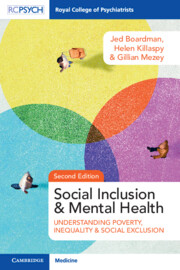Book contents
- Social Inclusion and Mental Health
- Reviews
- Social Inclusion and Mental Health
- Copyright page
- Contents
- Foreword to Second Edition
- Foreword to First Edition (2010)
- Preface
- Acknowledgements
- Chapter 1 Introduction: Poor, Excluded, and Unequal
- Section 1 Social Exclusion, Poverty, and Inequality
- Section 2 Participation of People with Mental Health Conditions
- Chapter 9 Mental Health Inequalities and Exclusion
- Chapter 10 Exclusion from Material Resources
- Chapter 11 Exclusion from Socially Valued Activities
- Chapter 12 Exclusion from Social Relations and Neighbourhoods
- Chapter 13 Exclusion from Health and Health Services
- Chapter 14 Exclusion from Civic Participation
- Chapter 15 Social Exclusion in Specific Social Groups and Individuals with Mental Health Conditions
- Chapter 16 Social Exclusion and People with Mental Health Conditions: Developing a Clearer Picture
- Section 3 Including People
- Index
- References
Chapter 16 - Social Exclusion and People with Mental Health Conditions: Developing a Clearer Picture
from Section 2 - Participation of People with Mental Health Conditions
Published online by Cambridge University Press: 24 November 2022
- Social Inclusion and Mental Health
- Reviews
- Social Inclusion and Mental Health
- Copyright page
- Contents
- Foreword to Second Edition
- Foreword to First Edition (2010)
- Preface
- Acknowledgements
- Chapter 1 Introduction: Poor, Excluded, and Unequal
- Section 1 Social Exclusion, Poverty, and Inequality
- Section 2 Participation of People with Mental Health Conditions
- Chapter 9 Mental Health Inequalities and Exclusion
- Chapter 10 Exclusion from Material Resources
- Chapter 11 Exclusion from Socially Valued Activities
- Chapter 12 Exclusion from Social Relations and Neighbourhoods
- Chapter 13 Exclusion from Health and Health Services
- Chapter 14 Exclusion from Civic Participation
- Chapter 15 Social Exclusion in Specific Social Groups and Individuals with Mental Health Conditions
- Chapter 16 Social Exclusion and People with Mental Health Conditions: Developing a Clearer Picture
- Section 3 Including People
- Index
- References
Summary
This chapter pulls together the findings presented in Section 2 on the extent of social exclusion in people with mental health conditions and the possible causal links between social exclusion and mental ill-heath and health, to build a descriptive model linking these. The evidence supports the contention that people with mental health conditions are excluded from participation in many areas of society and that there are clear social inequalities in mental ill-health. Although this is the case across all forms of mental health conditions, some groups are more at risk of exclusion than others. To build a picture of the relationship between mental health conditions and social exclusion we need to take into consideration the nature of the mental health conditions, material disadvantages, stigma and discrimination, and the effects of the wider community and society. The dynamic nature of exclusion must be considered, including its effects across the life course and generations and the interaction of the factors affecting exclusion. There are the strong contextual effects of material factors, summarised by the association of poor health with income inequality, suggesting that above a certain level economic growth does not produce an increase in population health and may be damaging.
Keywords
- Type
- Chapter
- Information
- Social Inclusion and Mental HealthUnderstanding Poverty, Inequality and Social Exclusion, pp. 321 - 346Publisher: Cambridge University PressPrint publication year: 2022

